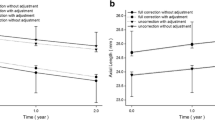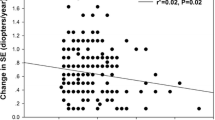Abstract
Purpose
To confirm the prediction of emmetropization feedback theory that myopia can be prevented by correcting the hyperopia of a child at risk of becoming myopic.
Methods
We conducted such myopia prevention treatment with twins at risk. Their hyperopia was partially corrected by one half at age 7 and in subsequent years until age 16.
Results
Hyperopia progressively decreased in all eyes as expected. None of the twins developed myopia. The spherical equivalent refractions of the followed eyes were +1 and +1.25 D at age 16. Feedback theory accurately predicted these values.
Conclusions
The treatment of the twins with partial correction of their hyperopia was successful. Prevention of myopia with this technique is relatively simple and powerful. The use of this myopia prevention treatment has no adverse effects. This prevention treatment is indicated in children with a hyperopic reserve at risk of developing myopia.



Similar content being viewed by others
References
Sorsby A, Benjamin B, Davey JB et al (1961) Emmetropia and its aberrations. MRC special report series no. 293. Her Majesty’s Stationery Office, London
Zadnik K (1997) Myopia development in childhood. Optom Vis Sci 74:603–608
Slataper FJ (1950) Age norms of refraction and vision. Arch Ophthalmol 43:466–481
Medina A (1987) A model for emmetropization: predicting the progression of ametropia. Ophthalmologica 194:133–139
Medina A, Fariza E (1993) Emmetropization as a first-order feedback system. Vis Res 33(1):21–26
Medina A (2015) The progression of corrected myopia. Graefes Arch Clin Exp Ophthalmol 253:1273–1277. doi:10.1007/s00417-015-2991-5
Gwiazda J, Thorn F, Bauer J, Held R (1993) Emmetropization and the progression of manifest refraction in children followed from infancy to puberty. Clin Vis Sci 8:337–344
Kempf GA, Collins SD, Jarman BL (1928) Refractive errors in the eyes of children as determined by retinoscopic examination with a cycloplegic. United States, 182. Government Printing Office, Washington
Ingram RM, Arnold PE (1991) Emmetropisation, squint and reduced visual acuity after treatment. Br J Ophthalmol 75:414–416
Medina A (1987) A model for emmetropization: the effect of corrective lenses. Acta Ophthalmol 65:565–571
Mutti DO (2007) Emmetropize or not to emmetropize? The question for hyperopic development. Optom Vis Sci 84(2):97–102
Zadnik K et al (2015) Prediction of juvenile-onset myopia. JAMA Ophthalmol 133(6):683–689. doi:10.1001/jamaophthalmol.2015.0471
Greene PR, Medina A (2016) Refraction data survey: 2nd generation correlation of myopia. Int Ophthalmol 36(9):609–614. doi:10.1007/s10792-016-0172-0
Vitale S, Sperduto RD, Ferris FL (2009) Increased prevalence of myopia in the United States between 1971–1972 and 1999–2004. Arch Ophthalmol 127:1632–1639
Wong L, Coggon D, Cruddas M, Hwang CH (1993) Education, reading, and familial tendency as risk factors for myopia. J Epidemiol Community Health 47:50–53
Fernández-Montero A, Olmo-Jimenez JM, Olmo N, Bes-Rastrollo M, Moreno-Galarraga L, Moreno-Montañés J, Martínez-González MA (2015) The impact of computer use in myopia progression: a cohort study in Spain. Prev Med 71:67–71
Rose KA, Morgan IG, Ip J, Kifley A, Huynh S, Smith W, Mitchell P (2008) Outdoor activity reduces the prevalence of myopia in children. Ophthalmology 115:1279–1285. doi:10.1016/j.ophtha.2007.12.019
Bullimore MA, Jones LA, Moeschberger ML, Zadnik K, Payor RE (2002) A retrospective study of myopia progression in adult contact lens wearers. Invest Ophthalmol Vis Sci 43(7):2110–2113
Kałuzny BJ, Koszewska-Kołodziejczak A (2005) Changes of eye refraction, corneal power and lens power during growth in emmetropia, myopia and hyperopia. Klin Oczna 107:464–467
Greene PR, Brown OS, Medina AP, Graupner HB (1996) Emmetropia approach dynamics with diurnal dual-phase cycling. Vis Res 36(15):2249–2251
Chia A et al (2012) Atropine for the treatment of childhood myopia: safety and efficacy of 0.5%, 0.1%, and 0.01% doses (atropine for the treatment of myopia 2). Ophthalmology 119(2):347–354
Shih YF et al (2001) An intervention trial on efficacy of atropine and multi-focal glasses in controlling myopic progression. Acta Ophthalmol Scand 79(3):233–236
Oakley KH, Young FA (1975) Bifocal control of myopia. Am J Optom Physiol Opt 52:738–764
Phillips J (2005) Monovision slows juvenile myopia progression unilaterally. Br J Ophthalmol 89:1196–1200. doi:10.1136/bjo.2004064212
Medina A (2016) Detecting the effect of under-correcting myopia. Graefes Arch Clin Exp Ophthalmol 254:409–410. doi:10.1007/s00417-015-3111-2
Acknowledgements
Special thanks to the dedicated mathematical assistance of Francisco Gaya. Funding was provided by Multivision Research.
Author information
Authors and Affiliations
Corresponding author
Ethics declarations
Conflict of interest
The authors have no proprietary or financial conflicts of interest.
Ethical approval
All procedures performed in studies involving human participants were in accordance with the ethical standards of the institutional and/or national research committee and with the 1964 Helsinki Declaration and its later amendments or comparable ethical standards.
Informed consent
Informed consent was obtained from all individual participants included in the study. Additional informed consent was obtained from all individual participants for whom identifying information is included in this article.
Appendix
Appendix
The feedback system output to an input lens of R diopters in the t-domain is the inverse Laplace transform of the output in the s-domain, which in turn is the transfer function times the step input in the s-domain:
where t is time, k is the time constant, I(s) is the step input in the s-domain, i(t) is the step input R in the time domain, O(s) is the output in the s-domain, o(t) is the output in the t-domain, L is the Laplace transform, and L −1 is the inverse Laplace transform.
Rights and permissions
About this article
Cite this article
Medina, A. Prevention of myopia by partial correction of hyperopia: a twins study. Int Ophthalmol 38, 577–583 (2018). https://doi.org/10.1007/s10792-017-0493-7
Received:
Accepted:
Published:
Issue Date:
DOI: https://doi.org/10.1007/s10792-017-0493-7




